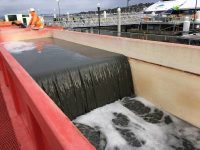Following a feasibility study that identified the best solution to remediate the concerns, Farallon conducted a pilot study to test the effectiveness of in-situ bioremediation, along with a removal action of hydrocarbon-impacted sediments in the cooling water loop that was submerged below groundwater. Sediments were vacuumed out along the 400-foot length of pipe and treated to separate out the hydrocarbon using a settling and separation water tank, followed by a gravity and centrifugal system. The remaining groundwater contamination was treated with an in-situ injection of an aerobic bioremediation compound.
To protect against future long-term migration to the bay, a reactive barrier wall will be installed. Groundwater monitoring wells are being sampled to evaluate the efficacy of the remedy and meeting the site closure criteria.



